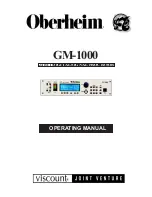
D*AP8 MAP
46
Setup GUI – DOLBY PROCESSING – Decoder/Emulation - Decoder
Active Mode
= Decoder
Decoder
Bitstream Format
[PCM / Dolby E 16/20/24 Bit
Dolby Digital / Dolby Digital
plus (I0, I0D0, I0I1, I0D0I1)]
where Ix and Dx stands for
independent and dependent
sub stream IDs
Bitstream Datarate
[of a D-D or D-D+ stream]
Decoder Status
[OK / Fail]
Program Configuration
[in case of D-E]
Channel Mode
[in case of D-D / D-D plus]
Dolby E Frame Rate
[detected by the D-E decoder]
Dolby D+ Decoding
[Main Only, Mixed Main & AD, AD Only]
Dolby Digital plus supports associated services like the provision of
extra dialog or sending an audio descriptive (AD) track for
visually impaired people or allows for separate commentary etc.
that may be mixed automatically or by user intervention (depending
on the consumer decoder implementation).
This selection allows you to listen to the main program only, the
main and the associated audio description (AD) signals mixed
together or the associated audio descriptive (AD) signal only.
It works only for streams where two Dolby Digital plus elementary
streams are multiplexed (AKA single PID operation). For dual PID
streams you may listen to the main and the associated signals
independently only, because the Dolby OEM module has only one
decoder input.
Downmix / PL II Program
[Program 1 / Program 2]
Selects the program for downmix or PL II decoding. The drop down
field becomes red colored if there is no second program available
(e.g. PL II decoding from a D-D / D-D+ stream).
Downmix Output Format
[AUTO / Lt/Rt / Lo/Ro / Pro Logic II]
AUTO=from Metadata, Lt/Rt (Pro Logic encoded), Lo/Ro (Stereo),
Pro Logic II encoded.
The decoding functions of the D*AP8 are implemented to meet all possible applications in the field.
Besides monitoring for QA, broadcasters use decoded consumer format (D-D/D+) streams for turn
around or backup applications. On the one hand they receive it from suppliers to add content to their
bouquet and on the other hand they must maintain older distribution systems (cable head ends)
which are based on AC3 encoding but (e.g.) are fed by D-D+. So often they can not / will not rely on
the received Dialnorm / DRC settings because they prefer to add automatic levelling and standard
DRC settings to all signals to have seamless loudness across their bouquet. That’s why we offer to
skip DRC & Dialnorm if it makes sense for the application.
Important Note! Metadata will be applied to the downmix output at any time. Either from the decoder or
from the MD Generator (if input format is PCM). The selection is only regarding the DRC profile which will
be used.















































